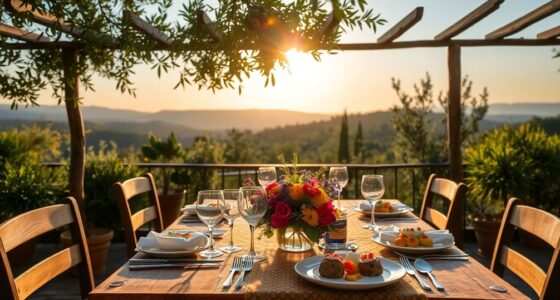"Al fresco dining" means "in the fresh air" in Italian, capturing the joy of enjoying meals outdoors. This tradition dates back to medieval times when outdoor feasts were exclusive to the wealthy. Over the centuries, it evolved as more people began hosting meals in gardens and parks, particularly during the Victorian era. Today, outdoor dining is a beloved way to connect with friends and family while reducing stress and enhancing mood. If you're curious about how this dining style has transformed over time or what makes it special today, there's so much more to explore!
Key Takeaways
- "Al fresco" means "in the fresh air" in Italian, emphasizing the enjoyment of outdoor dining.
- The concept dates back to medieval times when outdoor feasts were exclusive to the wealthy.
- By the 18th century, outdoor dining became popular among affluent Americans in private gardens.
- The Victorian era popularized picnics, making outdoor dining accessible to all social classes.
- Modern outdoor dining customs draw inspiration from historical pleasure gardens and communal meals.
Etymology of Al Fresco

The term "al fresco" captures the essence of dining outdoors, originating from Italian where it means "in the fresh air." This phrase reflects a cultural appreciation for enjoying meals outside, particularly in pleasant weather.
Historically, outdoor dining has been a cherished practice, and "al fresco" has evolved to signify these dining experiences in English-speaking cultures. While contemporary Italian uses terms like "fuori" and "all'aperto" for outdoor settings, "al fresco" remains prominent.
However, misconceptions arise; many associate it solely with casual meals, overlooking its broader implications. The adoption of "al fresco" highlights a cultural exchange, emphasizing not just the joy of outdoor dining, but also its rich linguistic history rooted in Italian traditions.
Historical Significance of Outdoor Dining
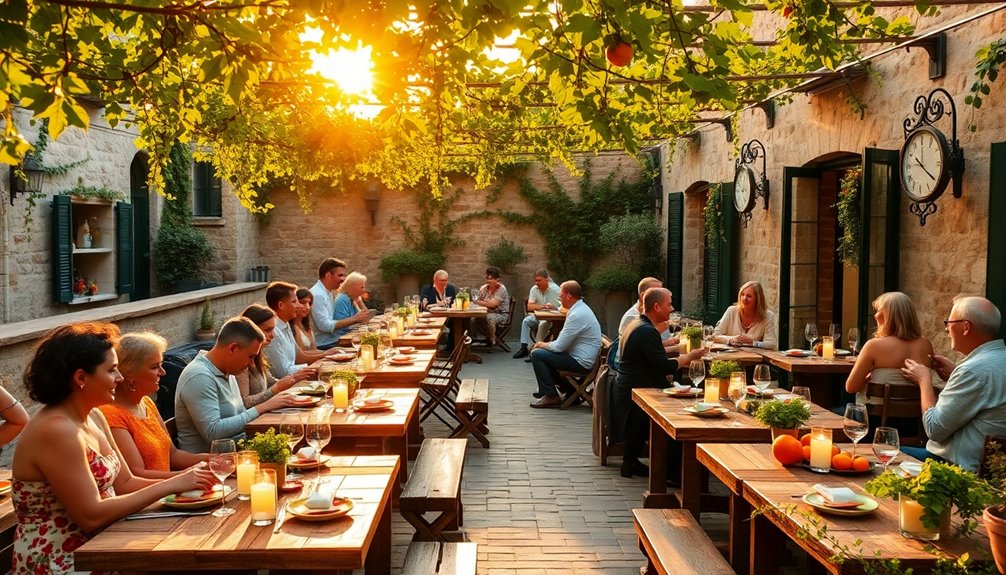
Outdoor dining has deep historical roots, reflecting cultural practices that have evolved over centuries. The term "al fresco," meaning "in the fresh air," originated from a historical practice that dates back to medieval times when outdoor feasts were primarily enjoyed by the wealthy.
By the 18th century, affluent Americans began hosting elaborate meals in private gardens, making outdoor dining more accessible. The Victorian era transformed this tradition, popularizing picnics across all social classes and establishing outdoor dining as a leisure activity.
In the early 1900s, seaside locations like Coney Island further embraced this trend, allowing patrons to eat in open spaces. Today, alfresco dining remains a cultural staple, continuing its legacy as a cherished way to enjoy meals outdoors.
Global Trends in Alfresco Dining
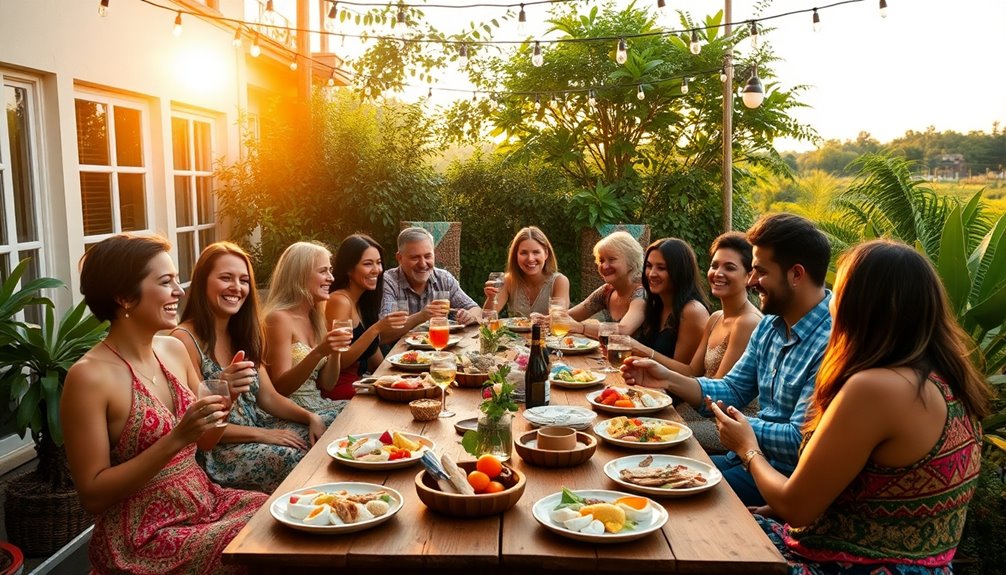
As cultures around the world evolve, alfresco dining has surged in popularity, transforming how people experience meals together.
This global phenomenon has taken many forms, from Spain's lively sidewalk tapas bars to England's elegant outdoor tea in gardens. In South Africa, communal braai gatherings highlight the importance of connection and community around shared meals.
The COVID-19 pandemic accelerated this trend, as you likely noticed a 292% increase in queries for al fresco seating options, reflecting a desire for safer social interactions.
Additionally, cities have recognized the economic benefits of outdoor dining, with over 40% of restaurant operators reporting increased daily sales due to expanded alfresco seating.
This shift in consumer preferences marks a significant change in the dining landscape. Furthermore, the rise of female participation in competitive gaming has shown that social interactions can extend beyond traditional dining experiences, creating new avenues for community building.
The Impact of COVID-19
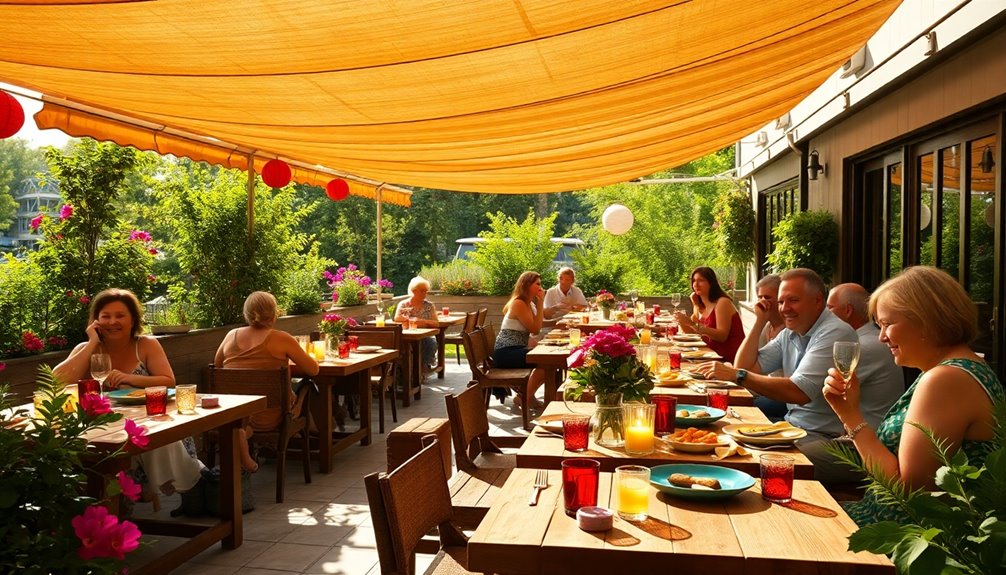
The COVID-19 pandemic transformed how you think about dining out, pushing restaurants to expand their outdoor spaces dramatically.
With safety in mind, many eateries embraced creative solutions like bubble tents and dining pods, meeting your demand for safe social interactions.
As you've adapted to these changes, cities are now making outdoor dining setups a permanent fixture, reflecting a lasting shift in your dining preferences. Additionally, many of these outdoor dining locations often feature scenic views that enhance the overall experience, similar to what you might enjoy while camping in nature.
Pandemic-Driven Outdoor Expansion
While many sectors struggled during the COVID-19 pandemic, restaurants seized the opportunity to transform their spaces and embrace outdoor dining.
In New York City alone, the number of sidewalk cafes skyrocketed from 1,023 to 10,600 by September 2020, showcasing a pandemic-driven expansion.
You likely noticed restaurants innovating outdoor spaces with bubble tents and dining pods, enabling safe social interactions while dining outside.
As consumer preference for al fresco dining surged, queries about outdoor dining increased by an astounding 292%.
This shift proved financially beneficial, with over 40% of restaurant operators reporting increased daily sales.
The pandemic not only changed how you enjoyed meals but also reshaped the landscape of dining, emphasizing the need for adaptable outdoor spaces. Additionally, many restaurants began incorporating portable outdoor heating solutions to extend the dining season, ensuring comfort for patrons during cooler months.
Long-Term Dining Changes
With the surge in outdoor dining spurred by the pandemic, many restaurants are now recognizing these changes aren't just temporary fixes.
The outdoor dining experience has become more popular than ever, with an impressive increase in consumer preference for restaurants featuring outdoor seating. Reports show about 40% of diners now favor alfresco options, and many operators noted higher daily sales thanks to this shift.
Innovative solutions like bubble tents and outdoor dining pods emerged to meet safety requirements, demonstrating restaurants' adaptability.
Cities are considering permanent outdoor dining installations, reflecting long-term changes in dining habits. As restaurants embrace this trend, they also benefit from a healthier lifestyle by promoting cleanliness and hygiene through well-maintained outdoor spaces.
As you enjoy your meals outdoors, it's clear that this trend is here to stay, reshaping how we think about dining out.
Benefits of Outdoor Dining

Outdoor dining isn't just a treat for your taste buds; it also boosts your health and happiness.
You'll find that fresh air and green surroundings can reduce stress and enhance your mood.
Plus, sharing a meal outside fosters stronger connections with friends and family, making every meal a little more special.
Health and Well-being
Dining al fresco offers a rejuvenating way to boost your health and well-being.
Outdoor dining not only immerses you in fresh air but also helps reduce fatigue and enhance relaxation.
Studies show that enjoying meals in natural surroundings considerably lowers stress levels, promoting essential mental health benefits.
Plus, eating outdoors encourages a slower, more leisurely pace, improving digestion and overall meal enjoyment.
Engaging with nature while dining heightens feelings of happiness, making your meals more memorable. Additionally, outdoor activities like hula hooping can complement your dining experience by promoting physical fitness and burning calories.
- Breathe deeply to enjoy the fresh air.
- Savor your meal slowly for better digestion.
- Choose a scenic spot for a calming atmosphere.
- Incorporate seasonal ingredients for freshness.
- Share your experience with nature to enhance joy.
Social Interaction Boost
While sharing a meal in the open air, you'll likely find that the relaxed atmosphere naturally sparks conversation and connection among diners.
Outdoor dining creates a unique ambiance that invites laughter and storytelling, enhancing social interaction. The fresh air and scenic views elevate your mood, making gatherings more enjoyable and memorable.
Plus, alfresco settings are perfect for larger groups, allowing family reunions and celebrations that strengthen bonds. Many restaurants are responding to the demand for outdoor space, with 61% of restaurateurs reporting an increase in interest for alfresco seating.
Sharing plates and communal dining styles further encourage engagement, ensuring everyone feels involved. Additionally, couples who travel together often find that shared experiences, similar to outdoor dining, can strengthen relationships and create lasting memories.
Creating an Alfresco Dining Space
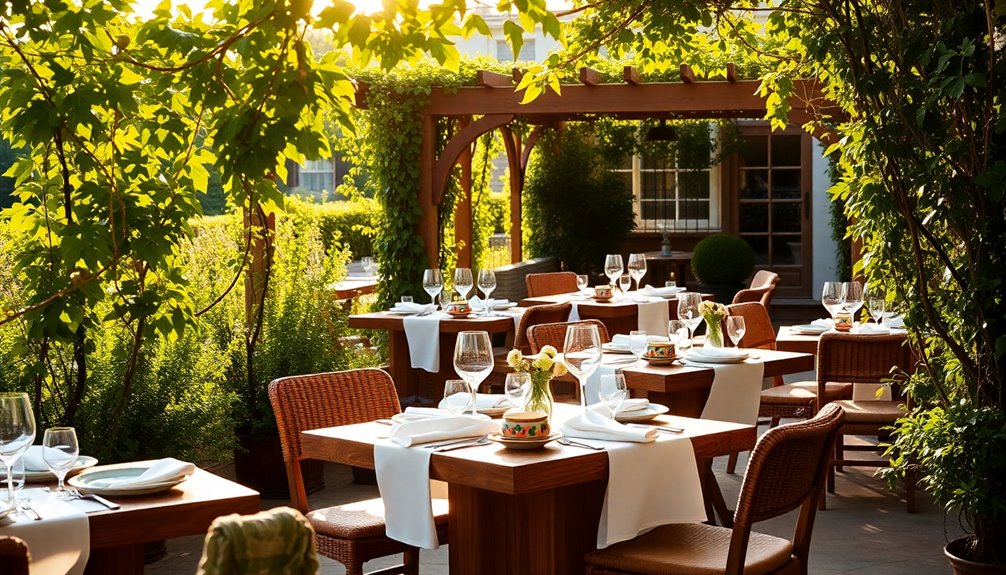
Creating an inviting alfresco dining space starts with prioritizing comfort and durability in your furniture choices.
Opt for comfortable seating and quality outdoor furniture that enhances your outdoor dining space's functionality and aesthetics. Consider using weather-resistant materials like powder-coated steel and quick-drying Sunbrella fabric to guarantee longevity.
To elevate your alfresco experience, remember to include:
- Quality outdoor tables, like those from the Haven Dining collection
- Outdoor heating solutions, such as fire pits or heat lamps
- Creative design elements, like awnings or canopies for shade
- Cozy cushions and throws for added comfort
- Ambient lighting to set the mood
Incorporating natural materials in your design can further enhance the overall aesthetic of your outdoor space.
These elements will help create a welcoming atmosphere for unforgettable outdoor meals.
Seasonal Considerations for Outdoor Dining
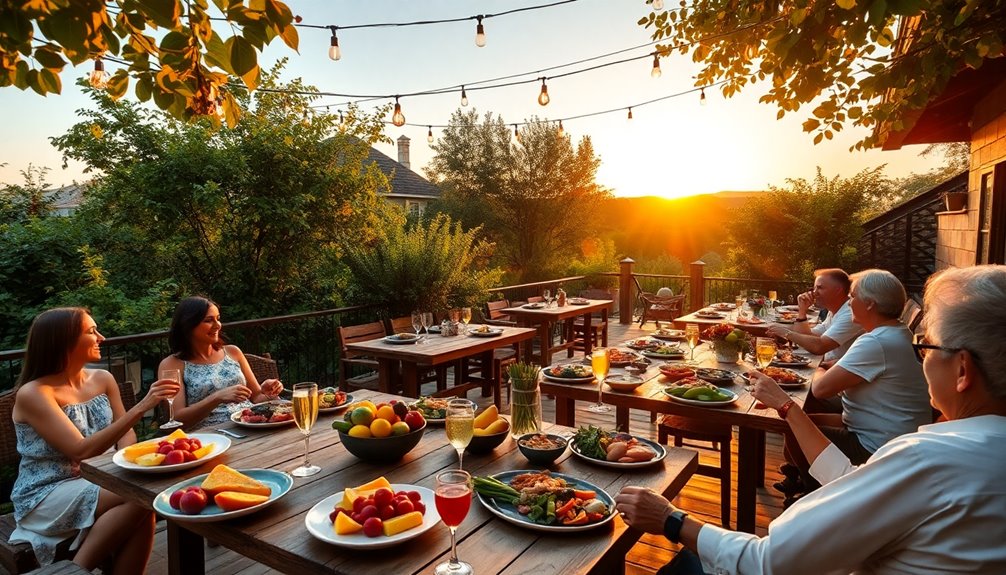
When planning your outdoor dining experience, consider the changing seasons and their impact on comfort and ambiance. The warmer months naturally draw diners outside, but you'll need to prepare for varying weather throughout the year. Here's a quick guide:
| Season | Considerations |
|---|---|
| Spring | Use durable furniture and add seasonal plants for color. |
| Summer | Provide shade options like umbrellas or awnings. |
| Fall/Winter | Incorporate heating solutions like fire pits to extend your outdoor dining area. |
Being mindful of these factors can enhance your outdoor setting. With protective measures against rain and wind, as well as a welcoming atmosphere, you can create an inviting alfresco dining experience all year long.
Popular Outdoor Dining Styles
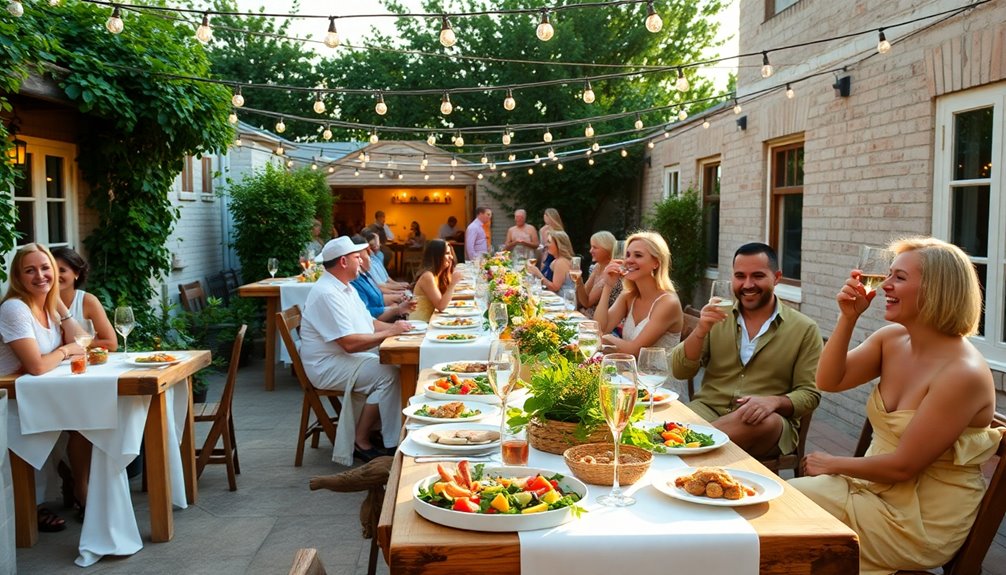
Outdoor dining styles offer a delightful way to enjoy meals in a variety of settings, each bringing its own unique charm and atmosphere.
From casual picnics to upscale rooftop venues, Al Fresco dining experiences cater to diverse tastes. Here are some popular outdoor dining styles you can explore:
- Italian trattorias with local wines and antipasti.
- English tea gardens serving traditional afternoon tea.
- Vibrant Spanish tapas bars with sidewalk seating.
- South African braai gatherings focused on communal cooking.
- Lively beer gardens offering craft brews and casual meals.
No matter your preference, these styles let you savor delicious food while soaking up the outdoors.
Inspiration for Alfresco Experiences

What makes alfresco dining so appealing? The charm of enjoying meals outdoors, surrounded by nature, creates an intimate atmosphere that enhances your dining experience.
The roots of al fresco can be traced back to the Middle Ages, where lavish outdoor feasts for the elite set the stage for today's outdoor dining culture. In the 1700s, pleasure gardens in America inspired a movement that still thrives, especially in urban areas.
You can now find alfresco experiences ranging from beachside picnics to garden parties, each fostering connection and social interaction.
The COVID-19 pandemic only heightened this trend, leading to innovative outdoor setups that prioritize safety while maintaining the joy of dining al fresco. Incorporating modern farmhouse style into outdoor dining spaces can enhance the overall aesthetic and comfort of al fresco experiences.
Embrace the beauty of meals in the fresh air!
Frequently Asked Questions
Why Is It Called Al Fresco Dining?
You might wonder why they call it al fresco dining. The term comes from Italian, meaning "in the fresh air."
When you dine al fresco, you enjoy your meal outdoors, embracing the beauty of nature around you. It creates a relaxed atmosphere, turning an ordinary meal into a delightful experience.
Whether you're at a café or in your backyard, al fresco dining invites you to savor your food in a revitalizing, open-air setting.
Where Does the Term Al Fresco Come From?
The term "al fresco" comes from the Italian phrase meaning "in the fresh air."
When you enjoy a meal outside, you're embracing this concept.
Over time, the phrase has evolved to signify the experience of dining outdoors, highlighting the joy of being surrounded by nature.
What Is the Meaning of Al Fresca?
Imagine dining under the stars, where every bite feels like a celestial event!
"Al fresco" means "in the fresh air," inviting you to savor meals outdoors, surrounded by nature's beauty.
It's not just eating; it's an experience that brings joy and relaxation. You get to enjoy the breeze, the scents, and the sounds of the outdoors while indulging in delicious food.
What Does "Served Al Fresco" Mean?
When you hear "served al fresco," it means your meal's enjoyed outdoors, surrounded by fresh air and nature.
This dining style enhances your sensory experience, making the food taste even better. You'll often find restaurants offering this option, allowing you to savor your meal in a relaxed, scenic atmosphere.
Whether it's breakfast, lunch, or dinner, dining al fresco creates a unique ambiance that adds to the enjoyment of your food.
Conclusion
So, next time you enjoy a meal under the open sky, think of it as a bridge connecting centuries of tradition to your plate. Just like a garden flourishes in sunlight, outdoor dining nurtures our spirits, offering fresh air and camaraderie. With 70% of diners now favoring alfresco experiences, it's clear that these vibrant settings aren't just a trend—they're a celebration of life itself. Embrace the moment, and let every bite be a toast to the great outdoors!




